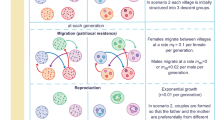Abstract
When two strains of Culex pipiens (s.l.) of different geographical origin are cross-mated, the cross is frequently sterile in one or both directions1. Such incompatibility is said to be cytoplasmic because the crossability of a strain is determined by its maternal lineage2. The incompatibility is caused in some way by infection with a rickettsia-like bacterial symbiote, as removal of the symbiote abolishes the incompatibility3. Incompatibility has not been observed in crosses of American strains of C. pipiens4–7. On the other hand, most workers in other parts of the world who have crossed C. pipiens strains have noticed incompatibility7–14, although there are no reports of incompatible egg rafts being collected in the field. We now report incompatibility in crosses of sympatric American strains of C. pipiens and the collection of incompatible egg rafts in the field.
This is a preview of subscription content, access via your institution
Access options
Subscribe to this journal
Receive 51 print issues and online access
$199.00 per year
only $3.90 per issue
Buy this article
- Purchase on Springer Link
- Instant access to full article PDF
Prices may be subject to local taxes which are calculated during checkout
Similar content being viewed by others
References
Laven, H. Evolution 5, 370–375 (1951).
Laven, H. Z. indukt. Abstamm.-u VererbLehre 85, 118–136 (1953).
Yen, J. H. & Barr, A. R. J. invert. Path. 22, 242–250 (1973).
Rozeboom, L. E. & Kitzmiller, J. B. A. Rev. Ent. 3, 231–248 (1958).
Barr, A. R. Proc. Calif. Mosquito Control Ass. 34, 32–35 (1966).
Espinola, H. N. & Consoli, R. A. B. Revta. bras. Malar. Doenc. trop. 24, 165–172 (1972).
Laven, H. in Genetics of Insect Vectors of Disease (eds Wright, J. W. & Pal, R.) 251–275 (Elsevier, Amsterdam, 1967).
Weyer, F. Arb. physiol. angew. Ent. Berl. 3, 202–208 (1936).
Marshall, J. F. & Staley, J. Proc. R. ent. Soc. Lond. A12, 17–26 (1937).
Roubaud, E. C. r. hebd. Séanc. Acad. Sci., Paris 212, 257–259 (1941); 242, 1557–1559 (1956).
Dobrotworsky, N. V. Proc. Linn. Soc. N.S.W. 80, 33–43 (1955).
D'Ancona, G. Parassitologia 4, 23–30 (1962).
Sasa, M., Shirasaka, A. & Kurihara, T. Jap. J. exp. Med. 36, 187–210 (1966).
Eyraud, M. & Mouchet, J. Cah. ORSTOM, Ser. ent. med. Parasit. 8, 69–82 (1970).
Subbarao, S. K., Krishnamurthy, B. S., Curtis, C. F., Adak, T. & Chandrahas, R. K. Genetics 87, 381–390 (1977).
French, W. L. Genetics 88, 447–455 (1978).
Caspari, E. & Watson, G. S. Evolution 13, 568–570 (1959).
Author information
Authors and Affiliations
Rights and permissions
About this article
Cite this article
Barr, A. Cytoplasmic incompatibility in natural populations of a mosquito, Culex pipiens L.. Nature 283, 71–72 (1980). https://doi.org/10.1038/283071a0
Received:
Accepted:
Issue Date:
DOI: https://doi.org/10.1038/283071a0
This article is cited by
-
Transovarian Transmission of Blochmannia and Wolbachia Endosymbionts in the Neotropical Weaver Ant Camponotus textor (Hymenoptera, Formicidae)
Current Microbiology (2018)
-
Eliminating female Anopheles arabiensis by spiking blood meals with toxicants as a sex separation method in the context of the sterile insect technique
Parasites & Vectors (2013)
-
Wolbachia Strengthens Cardinium-Induced Cytoplasmic Incompatibility in the Spider Mite Tetranychus piercei McGregor
Current Microbiology (2012)
-
Many compatible Wolbachia strains coexist within natural populations of Culex pipiens mosquito
Heredity (2011)
-
Wolbachia plays no role in the one-way reproductive incompatibility between the hybridizing field crickets Gryllus firmus and G. pennsylvanicus
Heredity (2008)
Comments
By submitting a comment you agree to abide by our Terms and Community Guidelines. If you find something abusive or that does not comply with our terms or guidelines please flag it as inappropriate.



